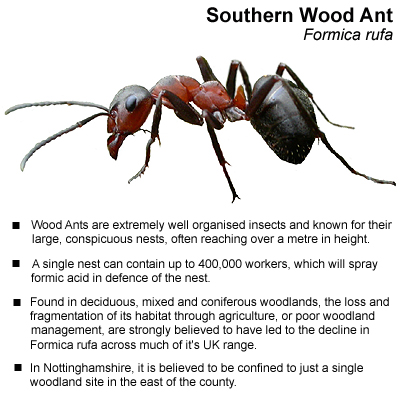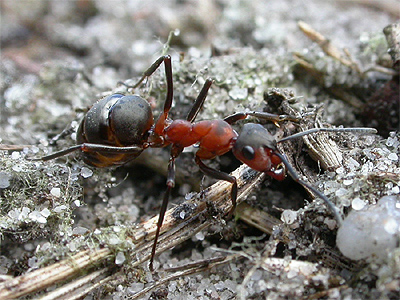

| The Wood Ant (Formica rufa) in Nottinghamshire |
| The Wood Ants are among
the UK's largest Ants. However, the common name of Wood
Ant, is often generalised by the authors of books and
websites and can actually refer to three very similar
species, following the extinction of a fourth UK species.
Wood Ants are extremely well organised insects and well known for their large, conspicuous nests, often reaching over a metre in height. These 'cities' are constructed from plant debris, including Pine needles and small twigs etc, which are layered together to form a dense, weather-proof thatch. A single nest can contain up to 400,000 workers, which are very defensive and will spray formic acid in defence of the nest, but this is actually not as bad as it sounds. Occasionally, several nests may be interconnected, effectively forming one large colony. Nest entrance holes are opened during the day and sealed again at night to maintain the optimal internal temperature and humidity within the nest. Collectively, Formica rufa colonies represent one of the major predators and scavengers of woodland insects, but also feed extensively on Aphid honeydew. However, they can be detrimental to species diversity found within woodland, by taking large numbers of invertebrates and their larvae. |
 |
|
| .... | ||
| National
distribution of the UK's four species of Wood Ant Formica rufa (Southern Wood Ant) is confined to England and Wales, where it is still locally common and is the species found at a single private Nottinghamshire site. In northern and eastern areas of England, there is evidence of a reduction in range over recent years. Although not given any national rarity status, the loss and fragmentation of habitat through agriculture, or poor woodland management, are strongly believed to have led to the decline in Formica rufa across much of it's range. Found in deciduous, mixed and coniferous woodlands and occasionally on scrub heath. Formica lugubris (Hairy Wood Ant) is found as far south as Derbyshire and Radnorshire. Its range overlaps with Formica rufa in northern Britain and north Wales and with Formica aquilonia in Scotland. Found in both deciduous and coniferous woodland, also in more open areas away from trees. There is one Nottinghamshire record from Wollaton dating from 1975. We have no current information regarding this Ant's continuing presence at this site, but it must be considered as being doubtful whether it still occurs there at all. Formica aquilonia (Scottish Wood Ant) is totally restricted to the Scottish Highlands and two localities in Co. Armagh in Ireland. National status Nb. This Ant is associated with undisturbed Caledonian pine forest and areas of mature Birch. Formica pratensis (Black-backed Meadow Ant) has only been recorded only from the Bournemouth area and Dorset heathland near Wareham, but became extinct in the late 1980's and there have been no further records since. It is still found on the Channel Islands. Used to occur in dry scrub heathland, woodland, meadows, hedgerows and grassy roadsides. |
||
| .... |
 |
Nottinghamshire
distribution of Formica rufa In Nottinghamshire, Formica rufa is restricted to one area of strictly private woodland in the east of the county near Girton. This information can be accessed easily via the NBN Gateway, so there seems little point in us not publishing it here. When we went to look for it in late March 2009, we easily found several rather inconspicuous nests situated in Bracken along the tree-line of a central clearing. We did not conduct a thorough search of the site, but did look for it at the Nottinghamshire Wildlife Trust's Spalford Warren reserve with negative results. There are very few suitable sites north of Newark where it would be worth looking for further colonies, so it does seem likely that this is Nottinghamshire's only site. Like many invertebrates, it would not be unreasonable to have expected Formica rufa to have been relatively common historically, yet it does seem to have always had a restricted distribution in Nottinghamshire. J.W. Carr lists it as being "common in the Fir woods about Thorney and Wigsley" (Carr) and also at Mansfield in 1912 (Staunt). |
|
| .. | ||
| The distribution of Formica rufa in counties adjacent, or near to Nottinghamshire seems just as unusual. The NBN Gateway lists very few sites and there are large distances between sites in Nottinghamshire, Lincolnshire, South Yorkshire, Leicestershire and Derbyshire. Such large distances between sites, leaves little chance of range expansion in the future and with suitable sites becoming increasingly more isolated through agriculture and urbanisation, this impressive Ant may continue to decline in parts of the UK. | ||